Last updated on
Discover the perfect color combinations that seamlessly blend with grey kitchen units, elevating your home’s aesthetic appeal and functionality.
Welcome to my latest blog post where we will be discussing one of the most popular kitchen design trends – grey units. Grey kitchens have become increasingly popular over the years due to their versatile nature and ability to complement a variety of styles and color schemes.
However, choosing the right colors to pair with your grey kitchen units can be a daunting task. Fear not, as in this article I will provide you with some expert advice on what colors go best with grey kitchen units and how you can create a cohesive and stylish look for your home.
So, whether you’re planning a full renovation or simply looking for some inspiration to update your existing space, read on for some top tips on how to make your grey kitchen stand out from the crowd!
Key takeaways:
- Choose warm or cool-toned grey shades based on the desired atmosphere.
- Pair warm greys with warm neutrals like cream or beige for a cozy look.
- Pair cool greys with blues or greens for a modern feel.
- Use neutral colors like white or beige to create a clean and sophisticated look.
- Add pops of color through accessories or accents for a vibrant touch.
What's Inside
Choosing the Right Grey Shade
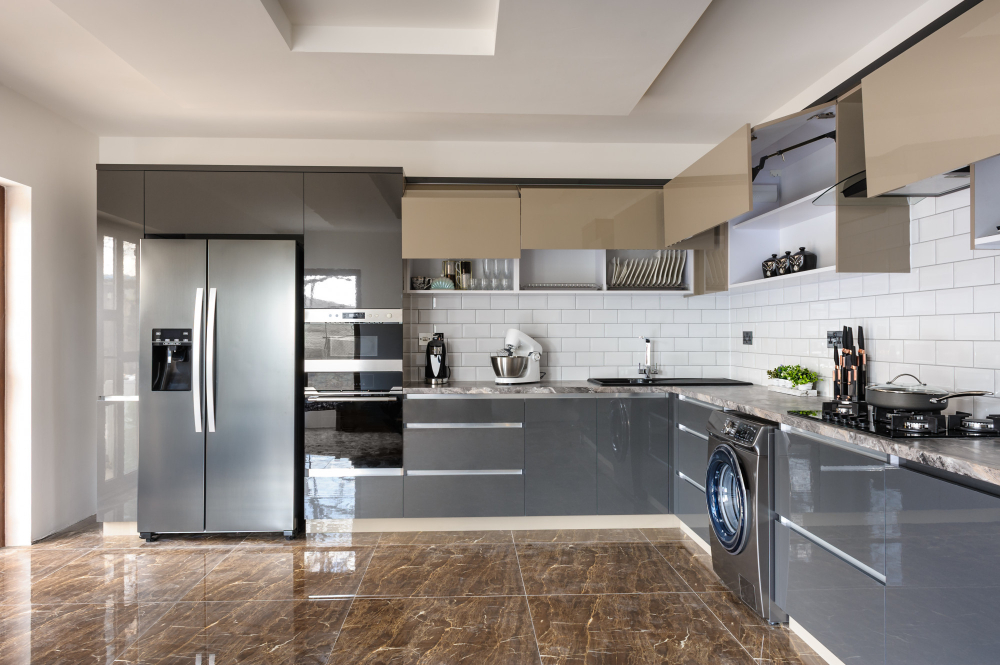
When it comes to choosing the right grey shade for your kitchen, there are a few things to consider. The first thing you need to decide is whether you want a warm or cool-toned grey.
Warm greys have yellow or brown undertones and can create a cozy and inviting atmosphere in your kitchen, while cool greys have blue or green undertones and can give off a more modern and sophisticated vibe.
Another factor that will influence your choice of grey is the amount of natural light in your kitchen. If you have plenty of natural light coming into the space, then lighter shades of grey may work well as they will reflect this light beautifully.
However, if your kitchen lacks natural lighting, then darker shades may be more appropriate as they can add depth and warmth to an otherwise dull space.
Warm Vs Cool Tones
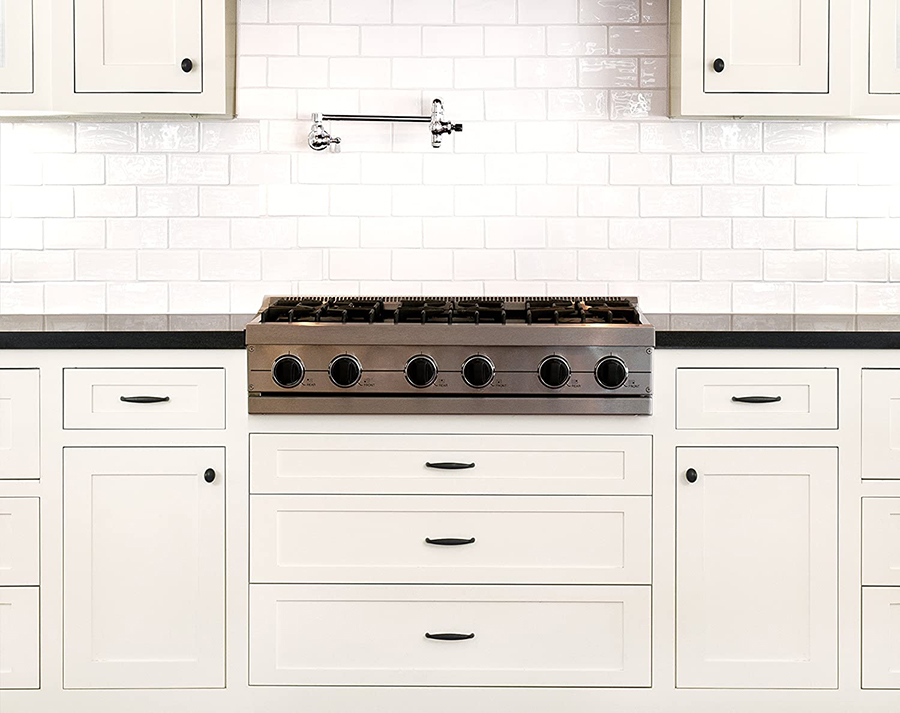
Warm tones are those that have a yellow, orange or red undertone and can create a cozy and inviting atmosphere in your kitchen. Cool tones, on the other hand, have blue or green undertones and can give your space a more modern feel.
If you’re looking for an earthy vibe in your kitchen design scheme then warm neutrals like beige, cream or taupe will work well with grey cabinets. These shades pair perfectly with natural wood accents such as butcher block countertops and hardwood flooring.
Alternatively, if you prefer cooler hues then consider pairing grey units with blues or greens which will add depth to your space while still maintaining its sleek look. Lighter shades of blue-grey paired together create an elegant monochromatic palette that’s perfect for contemporary kitchens.
Pairing With Neutral Colors
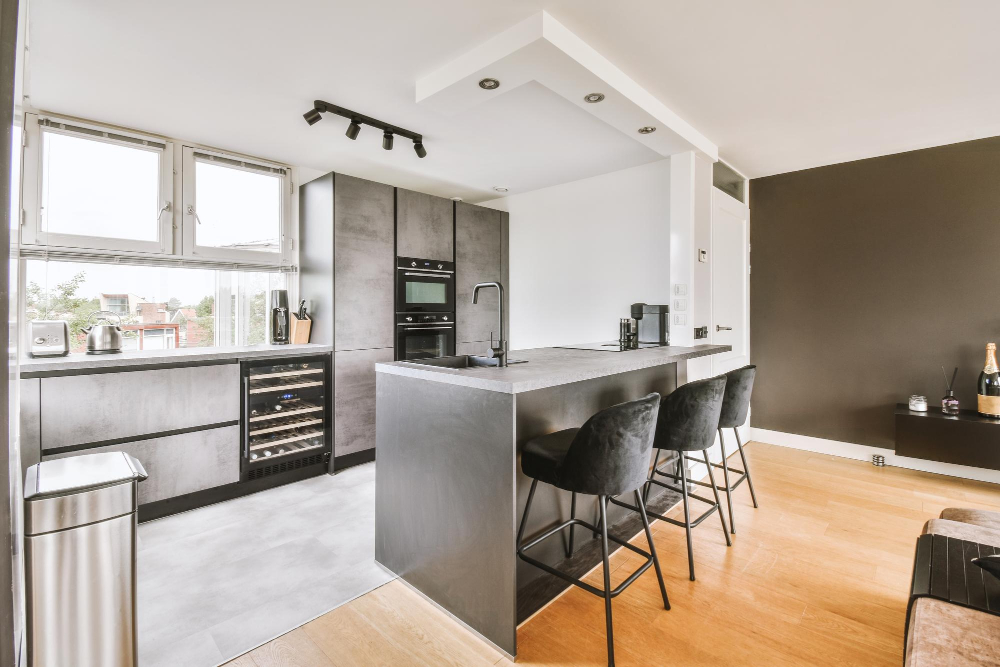
Neutral shades such as white, beige, cream or taupe can create a clean and sophisticated look in your kitchen while allowing the grey cabinets to take center stage.
When choosing neutral colors to pair with your grey units, consider the undertones of both hues. If you have cool-toned gray cabinets, opt for neutrals with blue or green undertones like icy whites or soft greens.
On the other hand, if you have warm-toned gray cabinets go for warmer neutrals like creamy whites or beige tones.
Neutral color schemes are also perfect if you want to add pops of color through accessories such as colorful dishware sets on open shelves or vibrant curtains on windows without overwhelming the space.
Pairing your grey kitchen units with neutral colors is an excellent way to achieve a timeless look that will stand up against changing trends over time.
Grey and White Combinations

This timeless color scheme creates a clean, fresh look that is both modern and elegant. When it comes to pairing grey units with white, there are several ways to achieve the perfect balance.
One option is to use white as the dominant color in your kitchen while incorporating grey accents through your cabinets or countertops. This approach works particularly well if you have a smaller space as it helps create an illusion of more room.
Alternatively, you can opt for darker shades of grey on your cabinets or island unit while keeping walls and backsplashes in crisp whites. This will add depth and dimensionality to your kitchen design without overwhelming the space.
Another way to incorporate this combination is by using different textures such as glossy tiles or matte finishes on cabinetry which adds interest without adding too much colour variation.
Warm Neutrals With Grey
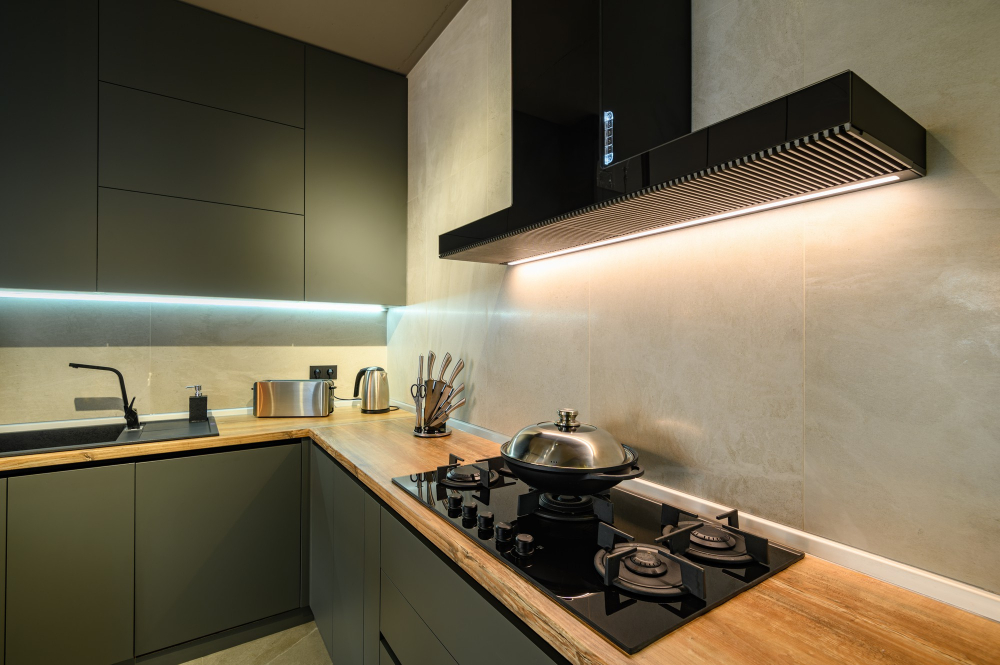
Shades like beige, cream, and taupe can add warmth to the space while still maintaining a neutral palette. These colors work particularly well in kitchens that receive plenty of natural light as they help to create an airy feel.
To achieve this look, try incorporating warm-toned accessories such as wooden cutting boards or copper cookware. You could also opt for a backsplash made from natural stone tiles in shades of beige or tan.
Another way to incorporate warm neutrals is by adding texture through fabrics such as curtains or seat cushions on dining chairs. This will not only add visual interest but also make the space feel more comfortable and welcoming.
Adding Bold Accents

This can be achieved through the use of colorful appliances, statement lighting fixtures or even brightly colored bar stools. A bright red toaster or kettle can instantly liven up a neutral grey kitchen while adding functionality at the same time.
Alternatively, if you prefer a more subtle approach, try introducing patterned textiles such as curtains or seat cushions in bold colors that complement your chosen accent shade. When it comes to choosing which color(s) to incorporate into your space as an accent hue(s), consider using complementary shades on the opposite side of the color wheel for maximum impact.
For example, yellow is an excellent choice for adding warmth and vibrancy when paired with cool-toned greys while blue hues work well with warm-toned greys. Remember that less is often more when it comes to incorporating bold accents into any room design – so choose one or two key pieces rather than going overboard with too many different colors and patterns competing for attention in one space!
Pops of Colour in Grey Kitchens
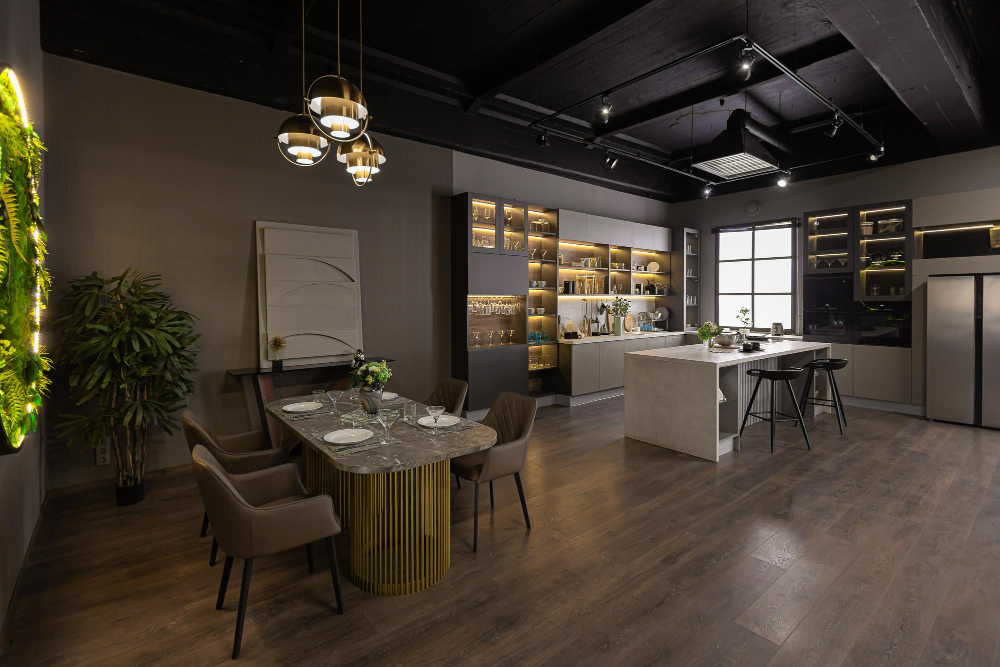
Whether you opt for bold, bright hues or subtle pastels, adding color can help break up the monotony of an all-grey space. One popular approach is to use colorful accessories such as dishware, vases or even small appliances like kettles and mixers that will add a splash of vibrancy without overwhelming the room.
Another option is incorporating colorful textiles such as curtains, seat cushions or tablecloths in complementary shades that work well with grey tones. This not only adds warmth but also helps tie together different elements in your kitchen design.
If you’re feeling adventurous and want to make more significant changes than just adding accessories or textiles, consider painting one wall in a bold accent color like red or blue for an eye-catching feature wall effect. Alternatively, if you prefer something more understated yet still impactful – try using patterned wallpaper on one section of the walls.
Highlighting With Pastel Colors
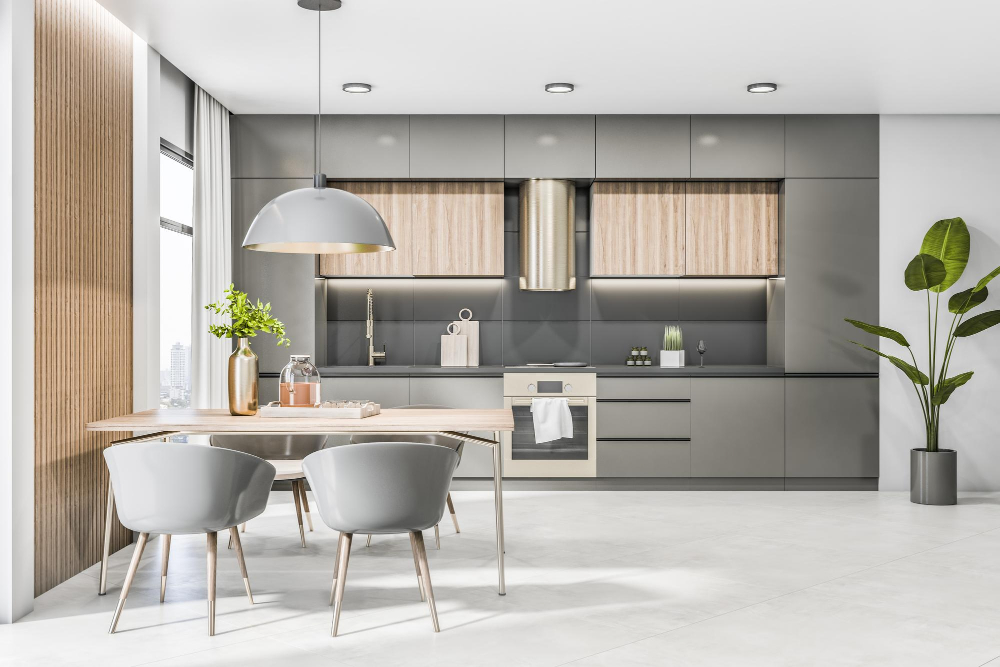
These muted hues work particularly well with light or medium shades of grey, creating an elegant and sophisticated look. Pastels such as pale pink, baby blue, mint green or lavender can be used on walls, cabinets or even in accessories like curtains and cushions.
To highlight your grey units with pastel colors effectively, consider using them sparingly throughout the space. For example, you could paint one wall in a soft shade of pink while keeping the rest of the room neutral.
Alternatively, you could opt for pastel-colored tiles for your backsplash or use patterned wallpaper featuring subtle hints of pastels.
When it comes to accessorizing with pastels in a grey kitchen setting – less is more! You don’t want to overwhelm the space by adding too many different colors that clash together; instead choose one main color (such as pale yellow) and then incorporate it into small details like tea towels or vases.
Overall highlighting with pastel colours is an excellent way to create contrast within your gray kitchen without overpowering its elegance.
Grey and Pastels
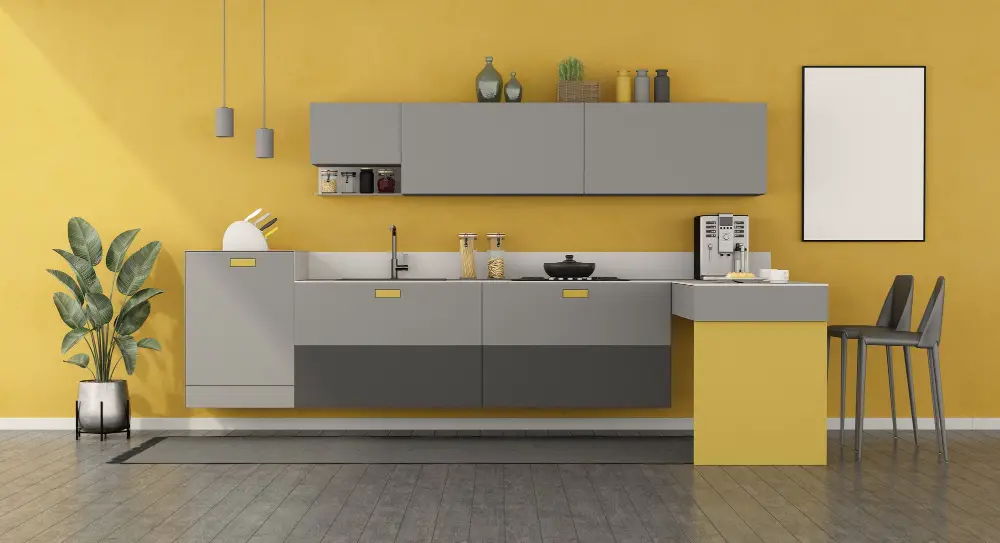
The soft, muted tones of pastel colors complement the coolness of grey kitchen units perfectly, creating a calming and serene atmosphere in your home. Pastel shades such as baby blue, blush pink or mint green can add warmth to your grey kitchen without overpowering it.
When incorporating pastels into your grey kitchen design, consider using them sparingly as accents rather than dominating the space. For example, you could opt for pale pink bar stools or mint green pendant lights to inject some color into an otherwise neutral space.
Another way to incorporate pastels is through accessories such as tea towels or small appliances like kettles and toasters. These subtle touches will create a cohesive look throughout the room while adding pops of color that won’t overwhelm the overall aesthetic.
Using Dark Hues for Contrast
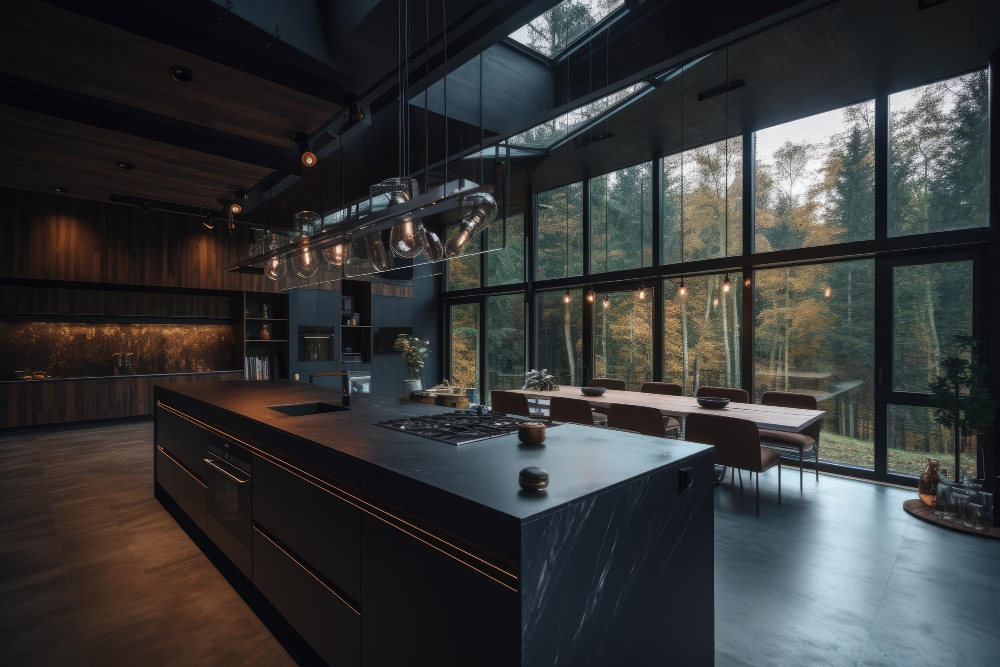
Deep blues, greens or even black can create a striking contrast against light grey units. For example, pairing navy blue cabinets with light grey countertops can create a bold yet sophisticated look that is sure to impress.
Another way of using dark hues in your kitchen design is by adding black accents such as cabinet handles or faucets. This will help break up the monotony of an all-grey color scheme while still maintaining its sleek and modern aesthetic.
When working with darker colors in your kitchen design, it’s important not to go overboard as too much darkness can make the space feel small and cramped. Instead, use these shades sparingly as accent pieces throughout the room.
Dark Grey Kitchen Contrasts
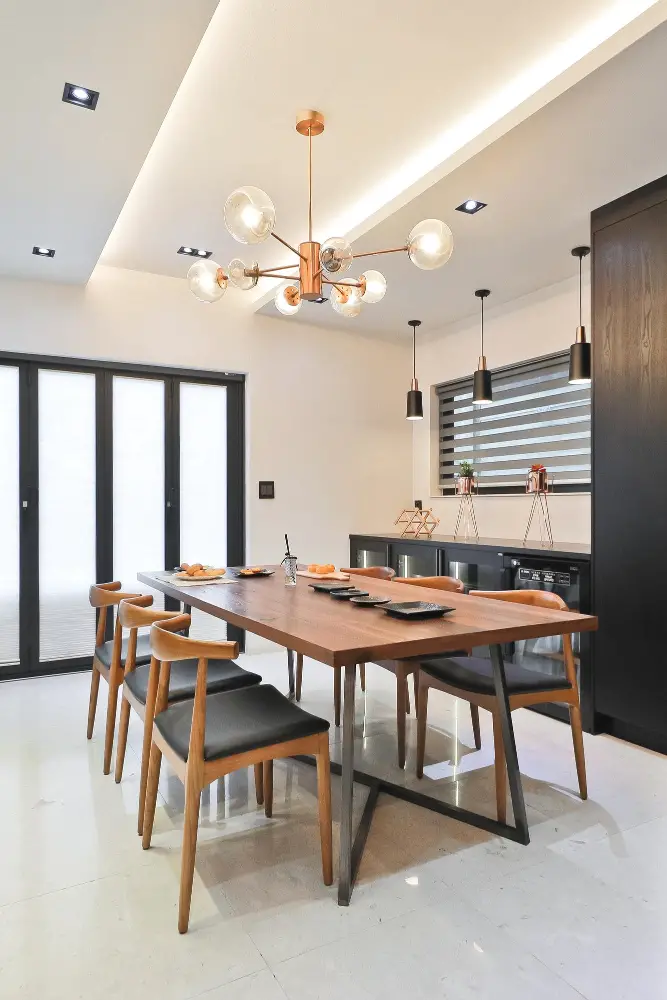
However, it’s important to balance the dark tones with contrasting colors to prevent the space from feeling too heavy or overwhelming. One way to achieve this is by pairing dark grey cabinets with lighter countertops, backsplashes, and flooring options.
For example, white marble or quartz countertops can provide a beautiful contrast against dark grey cabinetry while adding an elegant touch of luxury. Lighter wood textures such as oak or maple flooring also work well in creating visual interest without overpowering the space.
Another option for creating contrast is by incorporating bold accent colors into your design scheme. Bright pops of yellow or red can add energy and vibrancy to a darker kitchen while still maintaining its sophistication.
When working with darker hues like charcoal gray, it’s essential not only to consider color but also lighting conditions within your kitchen area carefully. Adequate natural light will help brighten up space and make it feel more inviting; however artificial lighting should be considered when designing any room that lacks natural light sources.
Light Grey Kitchen Palettes
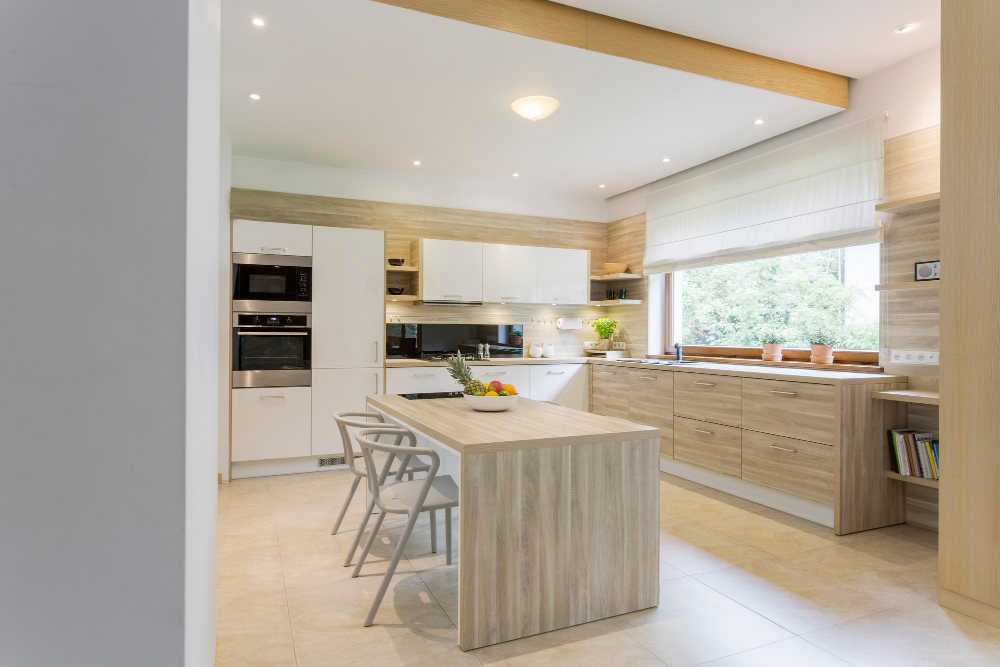
Lighter shades of grey can make your kitchen feel more spacious, while still providing the same level of sophistication as darker hues. When it comes to choosing colors that complement light grey cabinets, there are several options available.
One option is to pair light grey with other neutral tones such as white or beige. This creates a clean and classic look that will never go out of style.
Another option is to add pops of color through accessories like colorful dishware or decorative items on open shelves.
For those looking for something bolder, consider pairing light grey with brighter colors like yellow or blue-green for an unexpected pop in your kitchen design scheme.
When selecting countertops and backsplashes for your light-grey cabinetry, opt for materials in lighter shades such as marble or quartz with subtle veining patterns which will enhance the overall aesthetic appeal without overpowering the space’s natural brightness.
Mixing Grey With Wood Textures
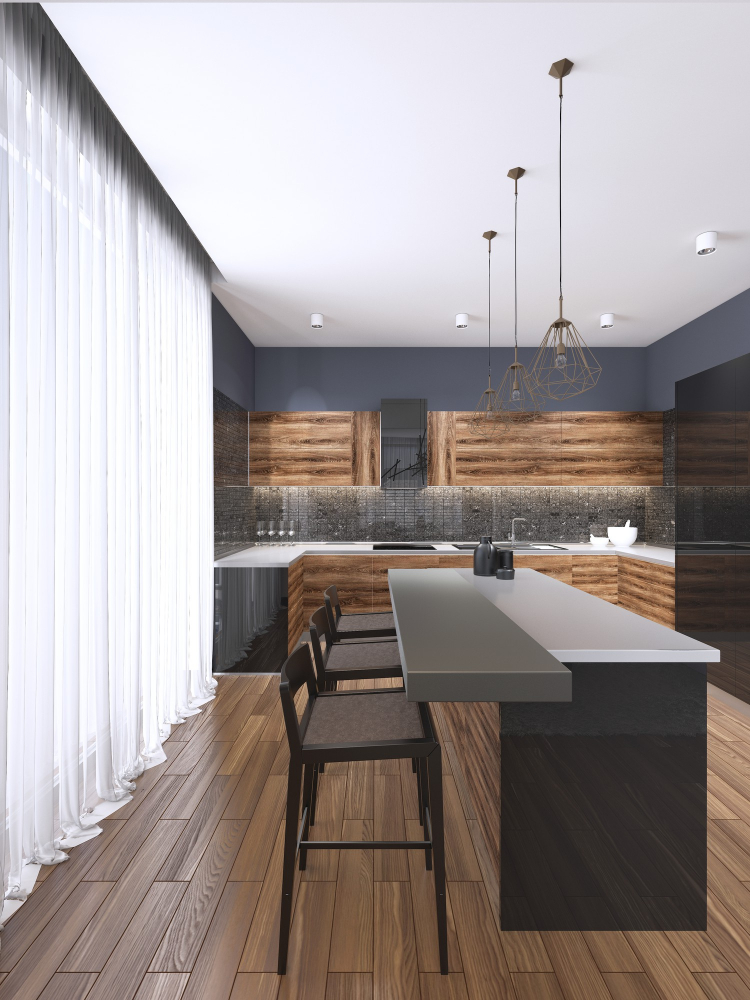
Wood accents can help soften the coolness of grey, creating a cozy and inviting atmosphere. When it comes to choosing the right wood tones for your grey kitchen units, consider using natural or light-colored woods such as oak or maple for a subtle contrast that won’t overpower the space.
For those who prefer darker woods, walnut or cherry can be used sparingly in small doses as an accent piece like on cabinet handles or countertops. It’s important not to go overboard with dark wood tones in order not to create too much contrast which may make your space feel unbalanced.
When mixing different materials together like this, it’s essential that you keep balance in mind so that one element doesn’t dominate over another. A good rule of thumb is 70% neutral colors (like greys) and 30% warm colors (like wooden textures).
This will ensure harmony between all elements within your design scheme.
Grey and Wood Accents

The natural warmth of wood textures adds depth and character to the cool tones of grey, creating a cozy yet modern feel in your kitchen. When it comes to incorporating wooden elements into your grey kitchen design, there are several options available.
One way is by using wooden cabinets or shelving units that complement the color scheme of your grey units. This creates an organic look that blends seamlessly with other natural materials such as stone or concrete countertops.
Another option is to use wooden flooring which can add warmth and texture while also providing contrast against sleeker surfaces like stainless steel appliances or glossy tiles.
If you’re looking for something more subtle, consider adding small touches like cutting boards, utensils holders or even bar stools made from reclaimed wood for an eco-friendly touch.
Metallic Accents in Grey Kitchens
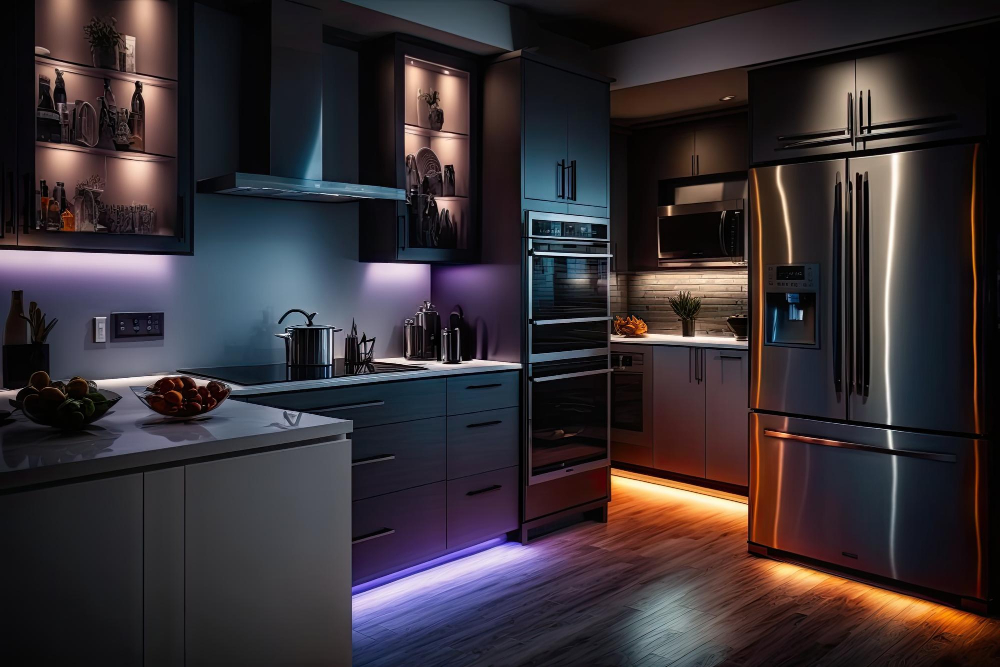
Whether you opt for gold, silver or copper, metallic finishes can create a stunning contrast against the cool tones of grey units. For instance, brass handles on cabinets or gold pendant lights above an island unit can make all the difference in elevating your kitchen’s style quotient.
When it comes to choosing metallic accents for your grey kitchen, consider the overall look and feel you want to achieve. If you’re aiming for a modern aesthetic with clean lines and minimalistic design elements, then sleek stainless steel appliances may be just what you need.
On the other hand, if warmth is what you’re after then copper or rose-gold fixtures could be perfect.
Another thing worth considering is how much metal should feature in your space – too much of it might overpower everything else! So try incorporating small touches like brushed nickel knobs on cabinetry doors or chrome faucets instead of going overboard with large statement pieces.
Kitchen Lighting Considerations
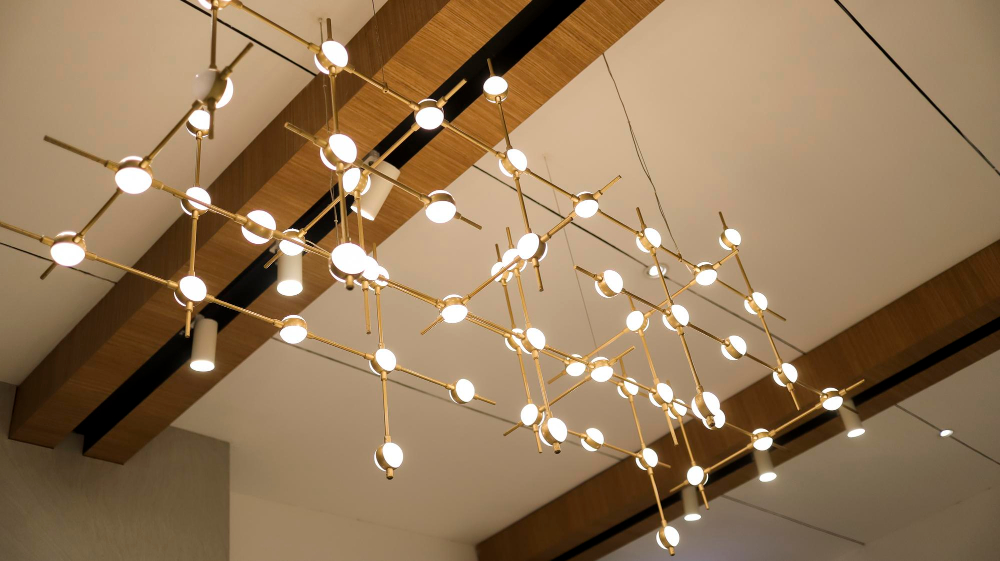
However, proper lighting can make all the difference in creating an inviting and functional space. In a grey kitchen, lighting becomes even more important as it can help enhance the color scheme and create different moods depending on the time of day.
Consider installing under-cabinet lights to highlight your countertops or adding pendant lights above your island for task lighting while cooking. If you have high ceilings or dark corners in your kitchen, consider adding recessed ceiling lights to brighten up those areas.
Natural light is also crucial when designing any room in your home but especially so for kitchens with grey units. Grey has a tendency to absorb light which can make spaces feel smaller than they are if not properly lit up by natural sunlight during daytime hours.
Incorporating large windows or skylights into your design will allow plenty of natural light into the space making it feel brighter and more open overall. Using lighter colored window treatments such as sheer curtains will allow maximum sunlight penetration while still providing privacy when needed.
Colours With Grey and Natural Light

If you’re lucky enough to have plenty of natural light, then it’s important to choose colors that will complement this feature. When it comes to pairing grey units with other colours, there are several options that work well in spaces filled with natural light.
One option is to pair grey cabinets with soft pastel shades such as pale pink or mint green. These gentle hues create a calming effect and add warmth without overpowering the space.
Another great option is combining grey units with earthy tones like beige or taupe for an organic feel that blends seamlessly into nature-inspired surroundings.
If you want something bolder, consider adding pops of bright color like yellow or orange which can help bring energy into your kitchen while still maintaining a cohesive look overall.
Choosing the Perfect Countertops
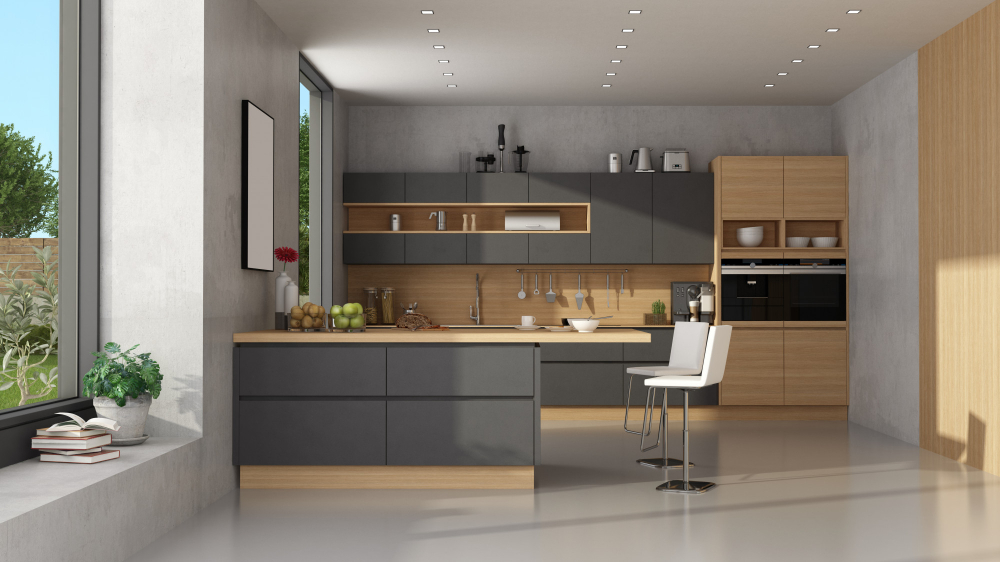
Firstly, you’ll want to think about the overall style and feel of your kitchen. If you’re going for a modern look, then sleek and glossy surfaces like quartz or granite can be an excellent choice.
On the other hand, if you prefer a more rustic or natural aesthetic, then wood or concrete countertops may be more suitable.
Another factor to consider is durability and maintenance requirements. While some materials like marble may look stunning in a grey kitchen setting, they can also be prone to staining and require regular upkeep.
If budget is not an issue for you when selecting countertop material options that complement gray cabinets include:.
- Quartz: A popular option due its durability.
- Granite: Another durable option with many color variations.
- Concrete: Provides unique texture options while being heat-resistant.
- Wood: Adds warmth but requires regular maintenance
- Laminate: Affordable yet stylish alternative
Ultimately it’s important that your chosen countertop complements both the color scheme of your grey units as well as any other design elements in your space such as backsplash tiles or flooring choices.
Selecting the Right Backsplash
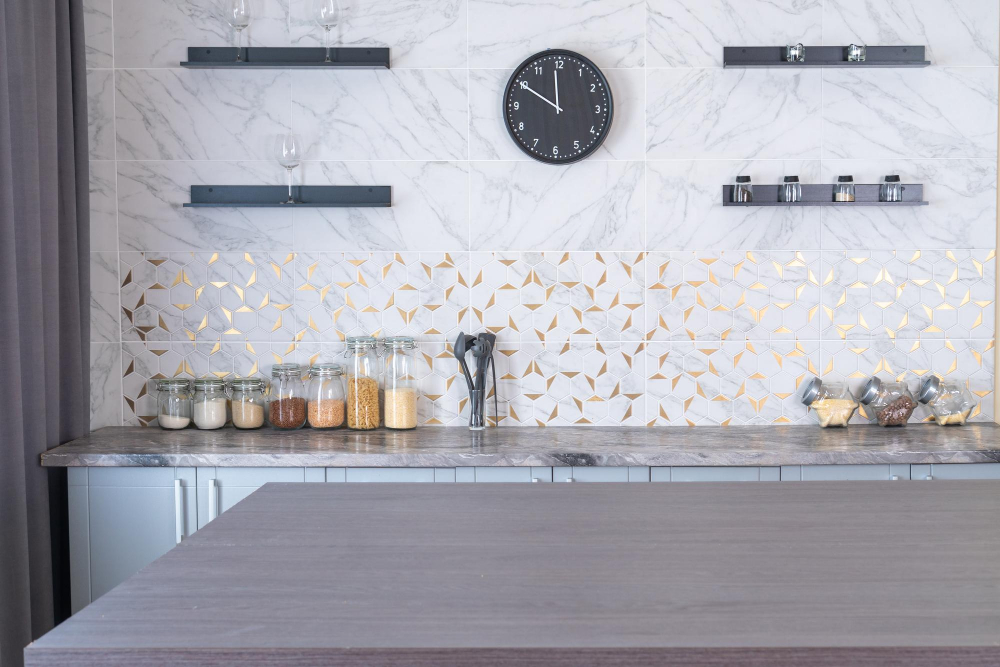
A backsplash can add texture, color and pattern to your space while also protecting the walls from spills and splatters. The right choice of backsplash can make all the difference in creating a cohesive look for your kitchen.
One option is to choose a neutral-colored tile that complements both grey cabinets and countertops. This will create an understated yet elegant look that won’t overpower other design elements in the room.
Another option is to go bold with colorful tiles or patterns that contrast with grey units, adding visual interest and personality into space. For instance, you could opt for blue or green subway tiles as they pair well with different shades of gray.
If you prefer something more subtle but still want some texture on your wall surface then consider using natural stone such as marble or granite which adds depth without being too busy visually.
Colourful Kitchen Hardware for Grey Units
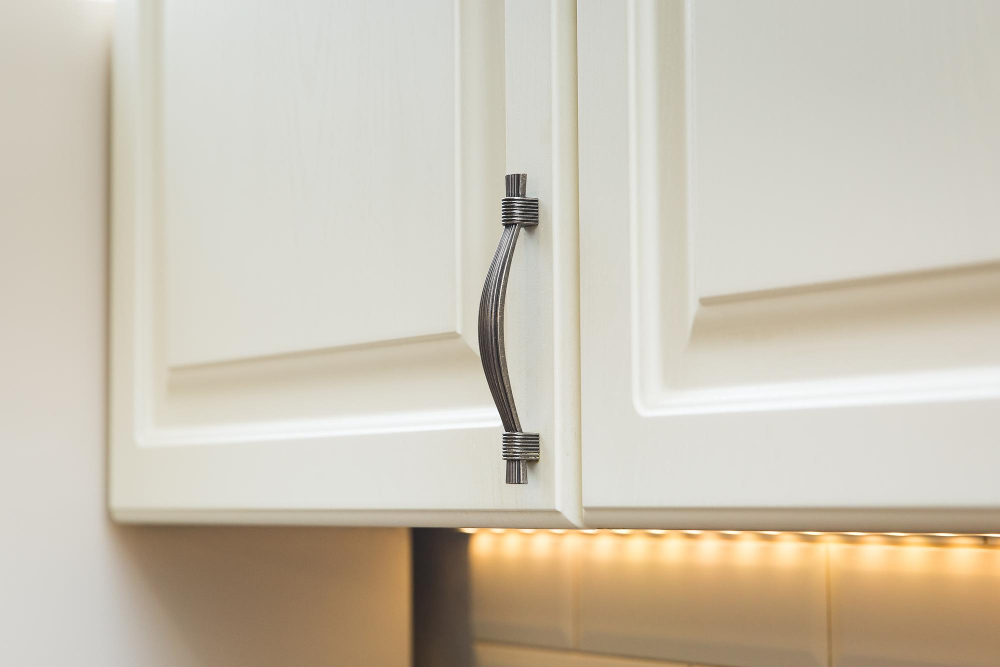
If you’re looking to add some color and personality to your grey kitchen units, consider incorporating colorful hardware such as knobs, handles or pulls. This is an easy way to inject some fun into your space without committing too much time or money.
There are many options available when it comes to colorful kitchen hardware for grey units. You could opt for bold hues like reds or blues that will stand out against the neutral backdrop of grey cabinets.
Alternatively, if you prefer a more subtle approach, pastel shades like mint green or baby pink can add a touch of whimsy without overwhelming the room.
Another option is metallic finishes in golds and coppers which pair beautifully with cool-toned greys creating an elegant contrast while adding warmth at once.
Whatever style you choose; be sure that they complement each other well so that they don’t clash with other elements in your kitchen design scheme.
Flooring Options for Grey Kitchens
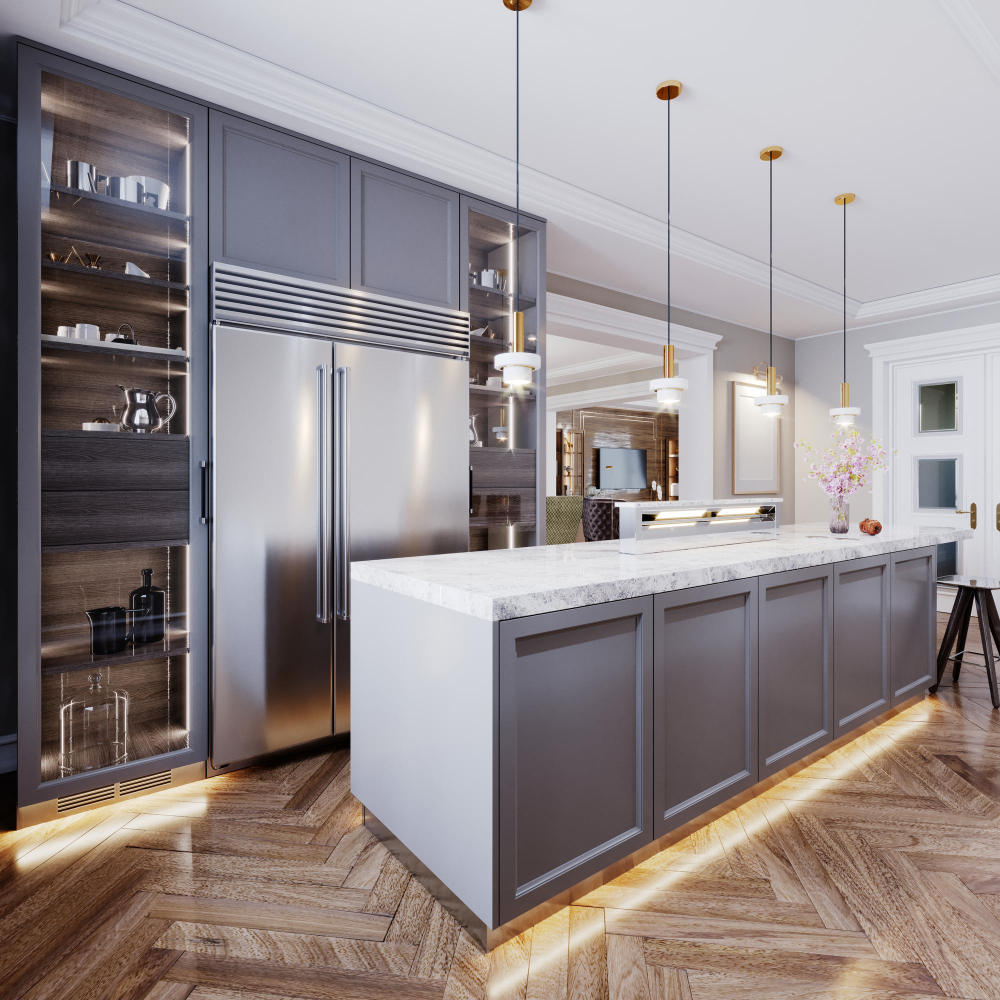
Firstly, you want something that complements the color scheme and style of your kitchen. Secondly, you need a material that is durable and easy to clean since kitchens tend to be high-traffic areas prone to spills and stains.
One popular option for grey kitchens is hardwood flooring. This classic choice adds warmth and texture while complementing the cool tones of grey cabinets.
If you’re looking for something more budget-friendly or low-maintenance, laminate or vinyl plank flooring can mimic the look of hardwood without breaking the bank.
For those who prefer tile floors in their kitchen space, porcelain tiles offer durability with endless design possibilities – from sleek modern styles in shades like charcoal gray or slate blue-gray hues through textured finishes such as wood grain effect tiles which add depth & interest underfoot whilst still being practical enough not only withstand heavy foot traffic but also resist moisture damage too!.
Grey and Earthy Tones

The combination of grey with natural, earthy hues such as beige, brown or green can create a warm and inviting atmosphere in your kitchen. Earthy colors add depth to the space while still maintaining the neutral palette that grey provides.
To achieve this look, consider incorporating wooden elements into your kitchen design such as cabinets or countertops made from natural wood materials like oak or walnut. You could also opt for stone countertops which will complement both the grey units and earth-toned accents.
When it comes to choosing accent colors for your accessories, think about shades found in nature like moss green or terracotta reds. These colours work well with greys because they provide contrast without being too bold.
Grey Kitchens With Blue Hues
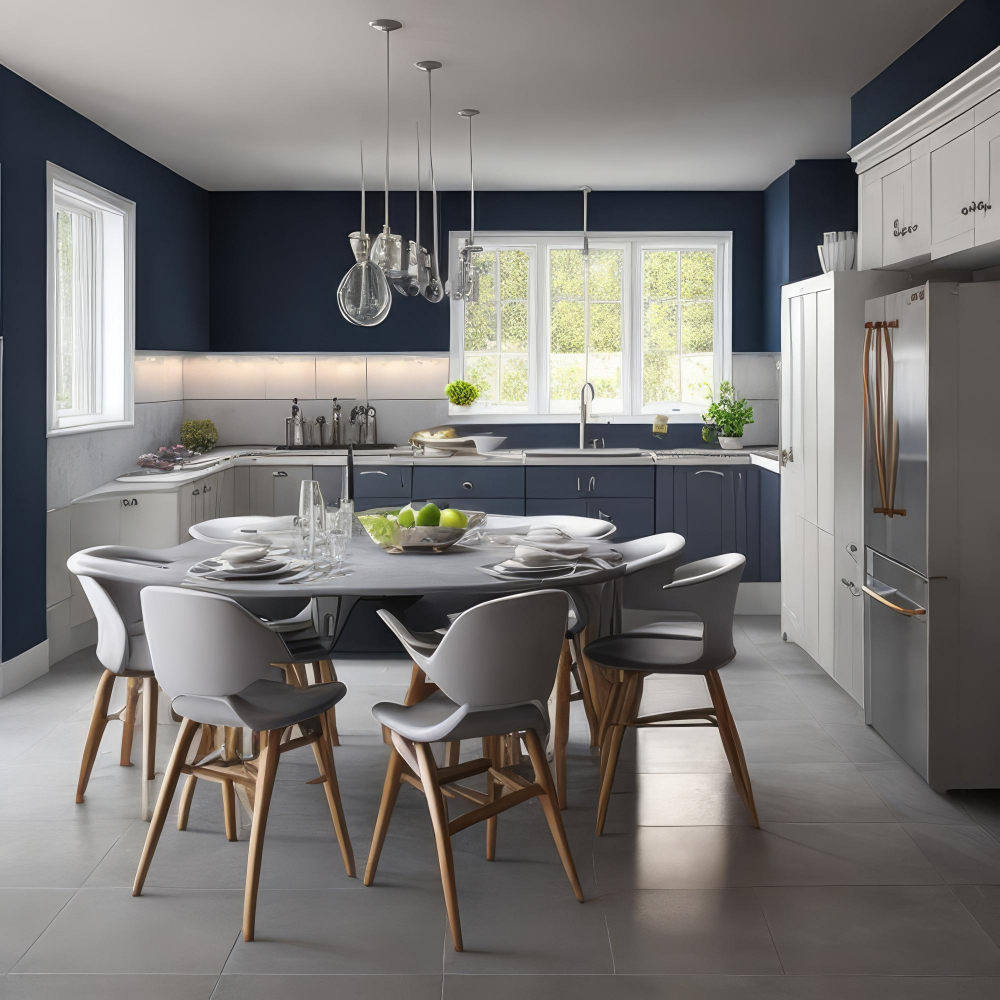
Whether you opt for light and airy pastel blues or bold navy shades, blue can create a calming and serene atmosphere in your kitchen space. Pairing grey units with blue accents is also an easy way to inject some personality into the room without overwhelming it.
For instance, if you have light grey cabinets in your kitchen, consider adding pale blue tiles as the backsplash or painting one wall in a soft shade of sky-blue. This will give the room depth while still maintaining its overall neutral feel.
On the other hand, if dark-grey cabinets dominate your space then deep navy walls could be just what’s needed for contrast and balance. You can also incorporate pops of brighter blues through accessories such as dishware or textiles like curtains or seat cushions on bar stools.
Grey and Green Colour Schemes
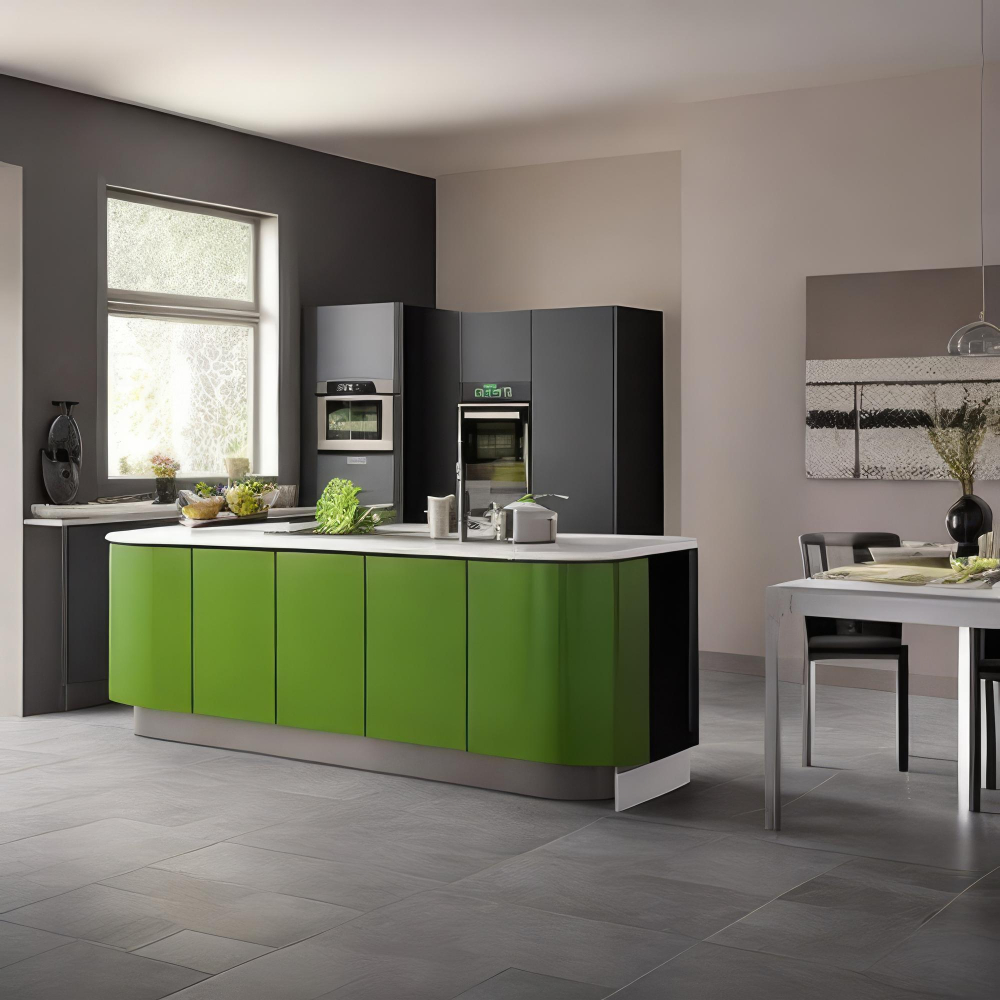
The cool, calming tones of grey pair perfectly with the fresh, natural hues of green to create a harmonious and inviting space. Whether you opt for light or dark shades of grey, pairing them with pops of vibrant greens can add depth and character to your kitchen design.
To achieve this look, consider incorporating green accents through plants or herbs on open shelves or windowsills. You could also introduce subtle touches such as patterned curtains or cushions in shades like sage green.
For those who want bolder statements in their kitchens, try painting an accent wall behind your cabinets using deep forest greens that will contrast beautifully against lighter greys. Alternatively, choose cabinetry painted entirely in soft minty-green tones paired with darker grey countertops for a modern yet timeless feel.
Monochromatic Grey Kitchens
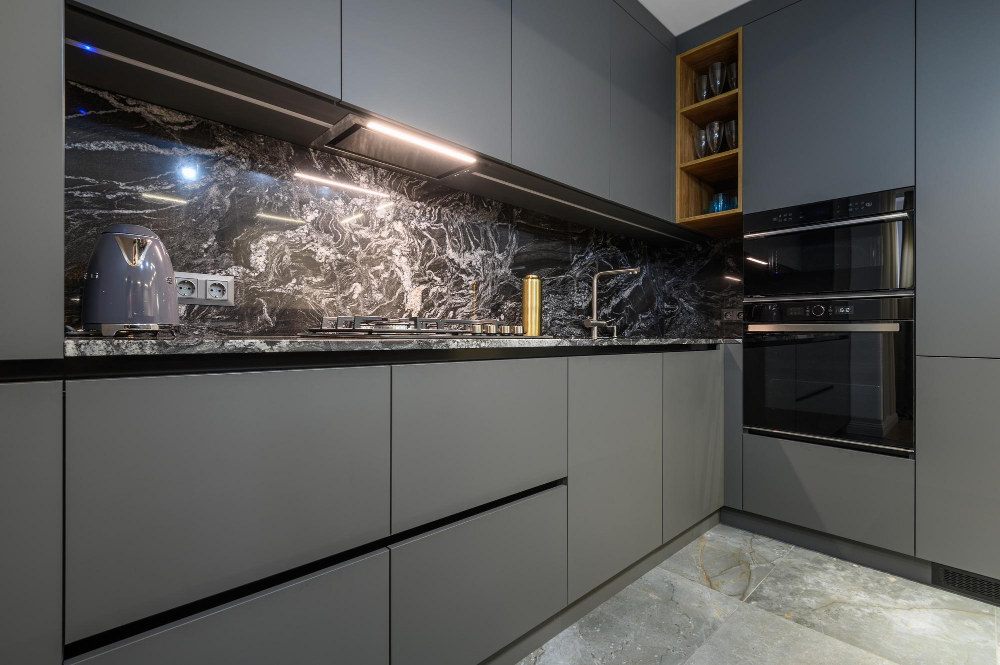
This design style involves using different shades of grey throughout the space to create depth and interest without introducing any other colors. To achieve this look, start by selecting your main shade of grey for the cabinets or walls and then incorporate lighter or darker shades in other areas such as countertops, backsplash tiles, flooring or even appliances.
One way to add texture to a monochromatic kitchen is by incorporating different finishes like matte vs glossy surfaces. For example, pairing matte gray cabinets with shiny stainless steel appliances can create an interesting contrast that adds visual appeal.
Another way to add dimension is through patterned tiles on the floor or backsplash area which can break up large expanses of solid color while still maintaining the overall monochrome theme.
When designing your own monochromatic grey kitchen be sure not to overlook lighting options as they play an important role in setting mood and highlighting key features within your space. Consider adding pendant lights over islands or under-cabinet lighting that will help illuminate workspaces while also providing ambiance during meal prep times.
Contemporary Colours for Dark Grey Kitchens
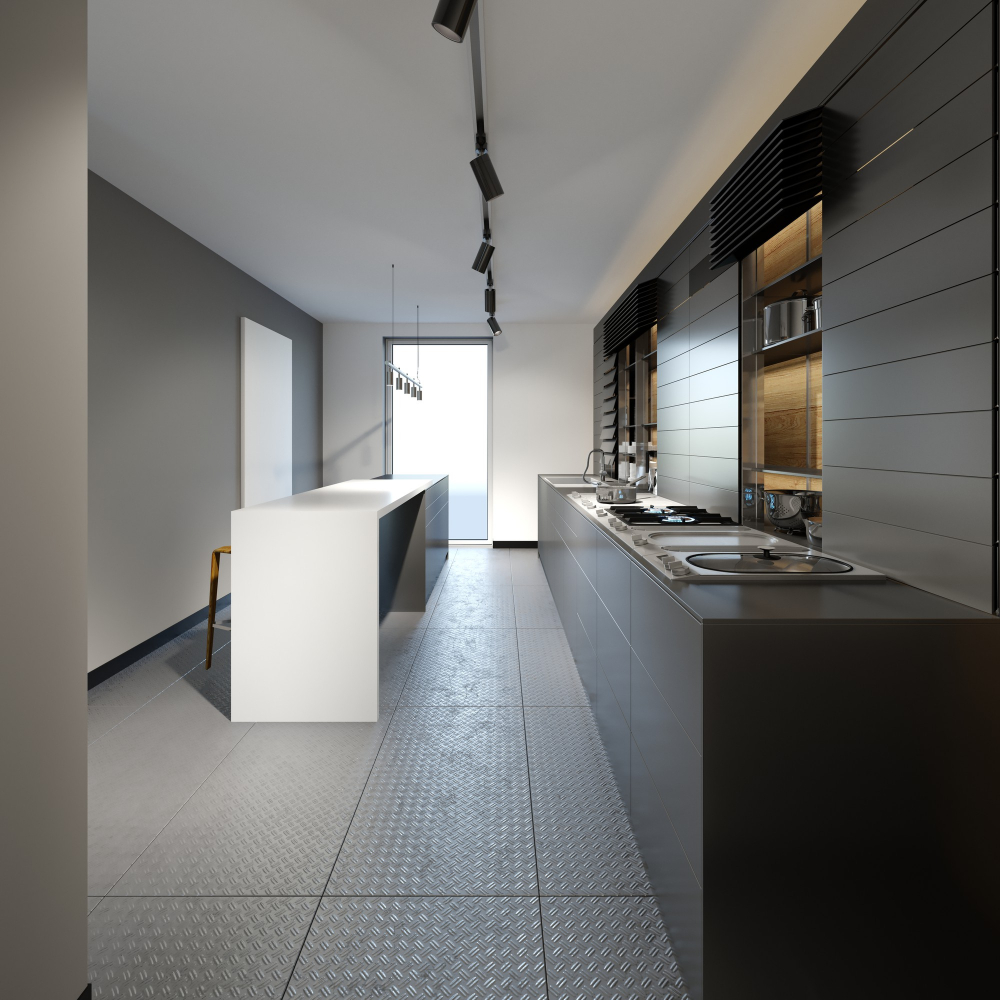
However, choosing the right colors to pair with dark grey units can be challenging. To achieve an on-trend and modern aesthetic, consider incorporating some of these contemporary color schemes into your kitchen design.
One option is to add pops of bright colors such as yellow or orange through accessories like bar stools or pendant lights. This will create a bold contrast against the dark grey cabinets while adding warmth and vibrancy to your space.
Another trendy color scheme that works well with dark grey kitchens is black and white monochromatic palettes. By using shades of black, white, and gray throughout your kitchen design you can achieve an elegant yet minimalist look that never goes out of style.
For those looking for something more daring but still chic, try pairing deep jewel tones like emerald green or sapphire blue with your dark gray cabinets. These rich hues will add depth and sophistication while creating an eye-catching focal point in any room they’re used in.
Kitchen Colours for Light Grey Cabinets
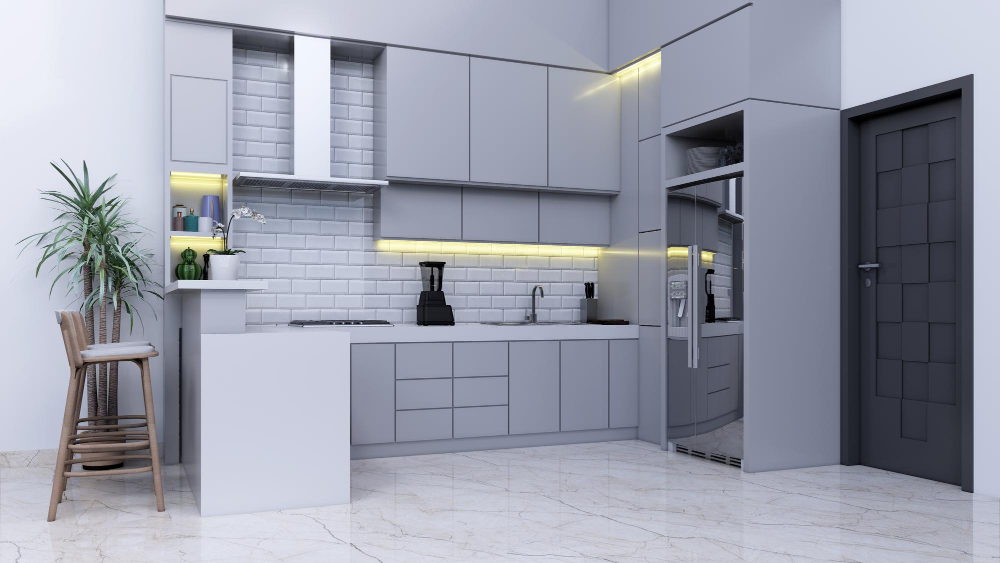
However, choosing the right colors to pair with light grey can be tricky. The key is to find colors that complement the softness of light grey without overpowering it.
One option is to go for pastel shades such as pale pink or baby blue. These gentle hues add warmth and depth while maintaining an overall soft look in your kitchen.
Another great color combination for light grey cabinets is white or off-white tones. This creates a clean, fresh look that’s perfect if you’re going for a minimalist style in your home.
If you prefer bolder accents, consider adding pops of yellow or green into your design scheme – these colours work particularly well with lighter greys and will help bring some life into the room without being too overwhelming.
Colour Palettes for Grey Kitchens With Natural Accents

Natural accents such as wood textures, stone countertops or greenery can add warmth and depth to your space while complementing the coolness of grey units.
When it comes to choosing colors for a grey kitchen with natural accents, consider warm neutrals like beige or taupe which will blend seamlessly with wooden elements. Alternatively, shades of green can bring an outdoor vibe into your home while adding freshness and vitality.
For those who prefer bolder color choices, deep reds or oranges can be used sparingly as accent colors on walls or accessories for added interest without overwhelming the space.
Contrasting and Complementary Kitchen Wall Colours
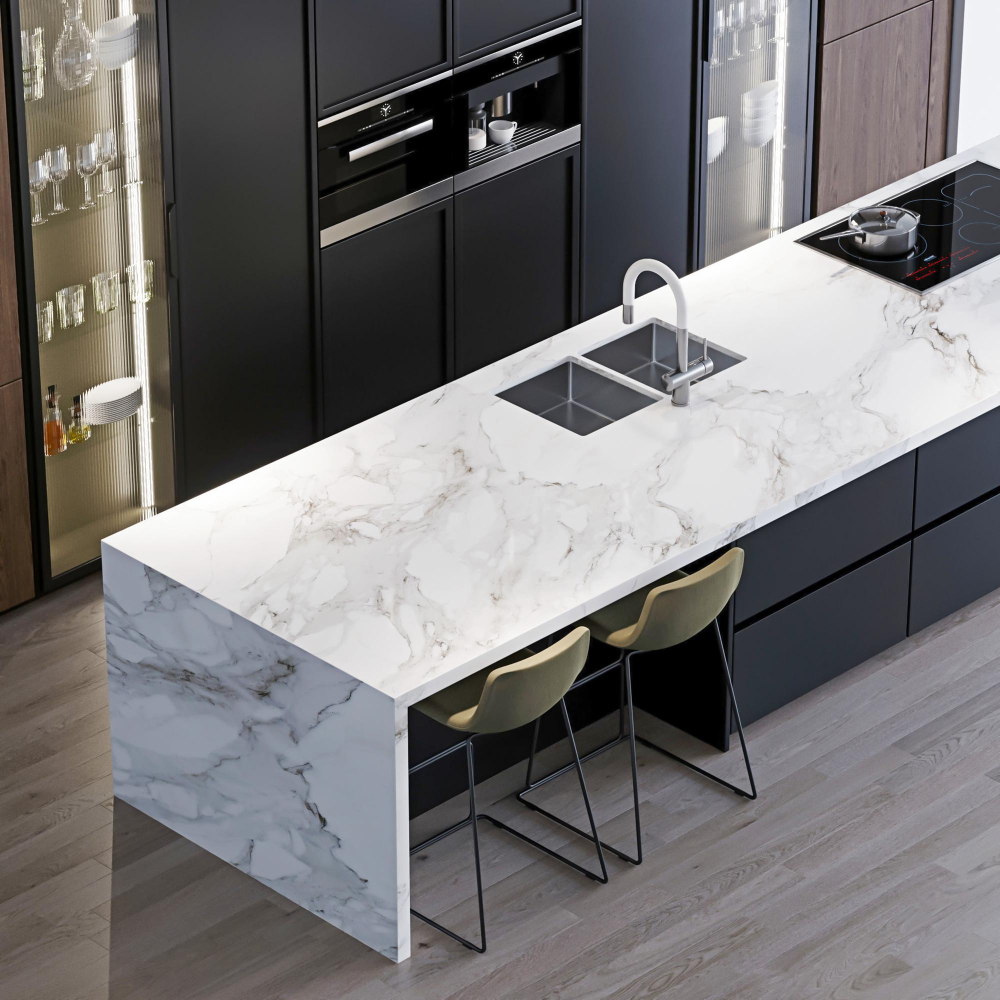
Contrasting colors create a bold and dramatic effect by using hues that are opposite on the color wheel. For example, pairing grey units with a bright yellow or orange accent wall can add energy and vibrancy to your space.
On the other hand, complementary colors use hues that sit next to each other on the color wheel. This approach creates a harmonious and cohesive look by selecting shades that share similar undertones but differ in intensity or brightness level.
For instance, pairing light grey cabinets with soft blue walls can create an elegant yet calming atmosphere in your kitchen.
Ultimately, whether you choose contrasting or complementary colors will depend on personal preference as well as factors such as lighting conditions and overall design style of your home.
Grey Kitchen Ideas: Mix Grey and Yellow
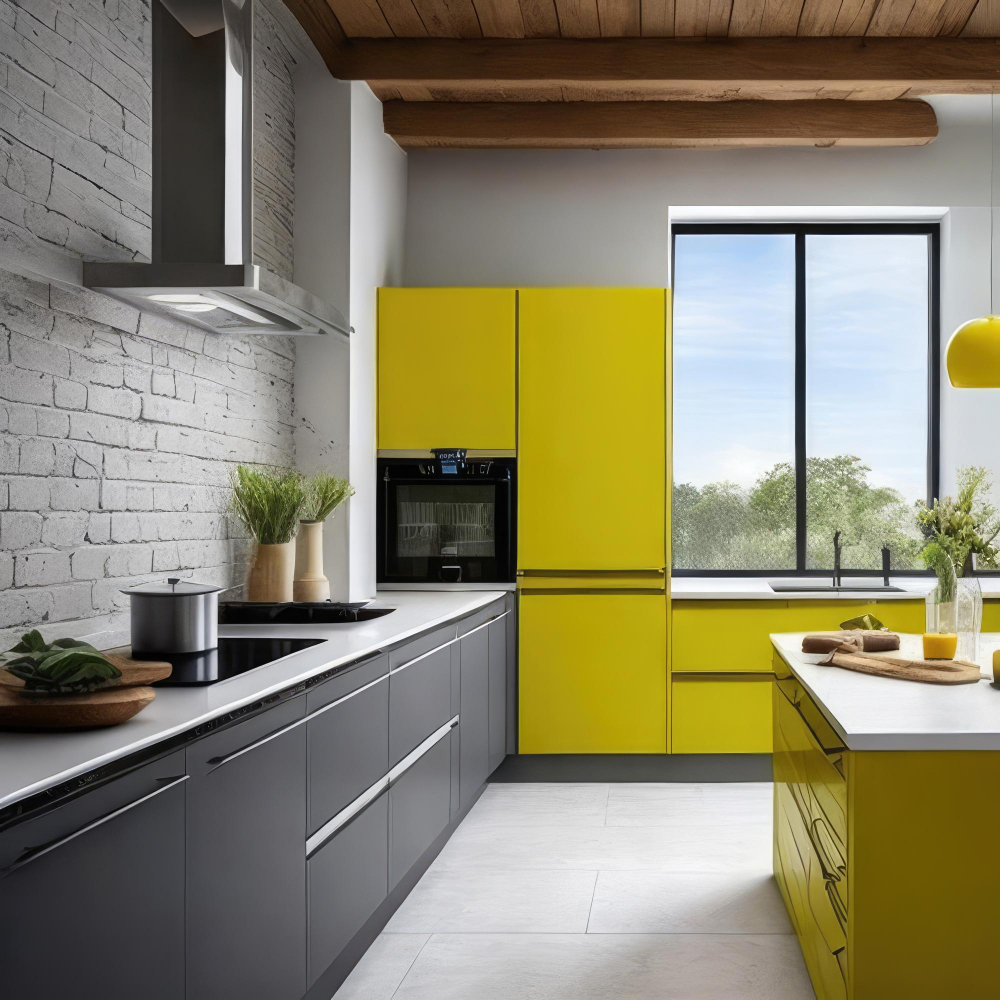
The combination of grey and yellow creates a fresh, modern look that is both stylish and inviting.
To achieve this look, start by selecting the right shade of yellow. A bright lemon or mustard hue can be too overwhelming in large doses, so opt for softer shades like pale yellows or buttery tones instead.
Once you’ve chosen your shade of yellow, think about how you want to incorporate it into your space. You could choose some statement pieces such as a bold patterned rug or curtains with pops of the sunny hue; alternatively go for smaller accessories like cushions on chairs or bar stools.
Another way to introduce this colour scheme is through kitchen appliances such as kettles and toaster sets which are available in various shades from pastel lemon hues all the way up to vibrant sunshine yellows!.
When mixing grey with any other color always remember balance is key! Too much gray can make space feel cold while too much bright colors may overwhelm it – so aim for an even distribution between these two colours throughout different elements within your design scheme.
Grey Kitchen Ideas: Add a Hint of Gold
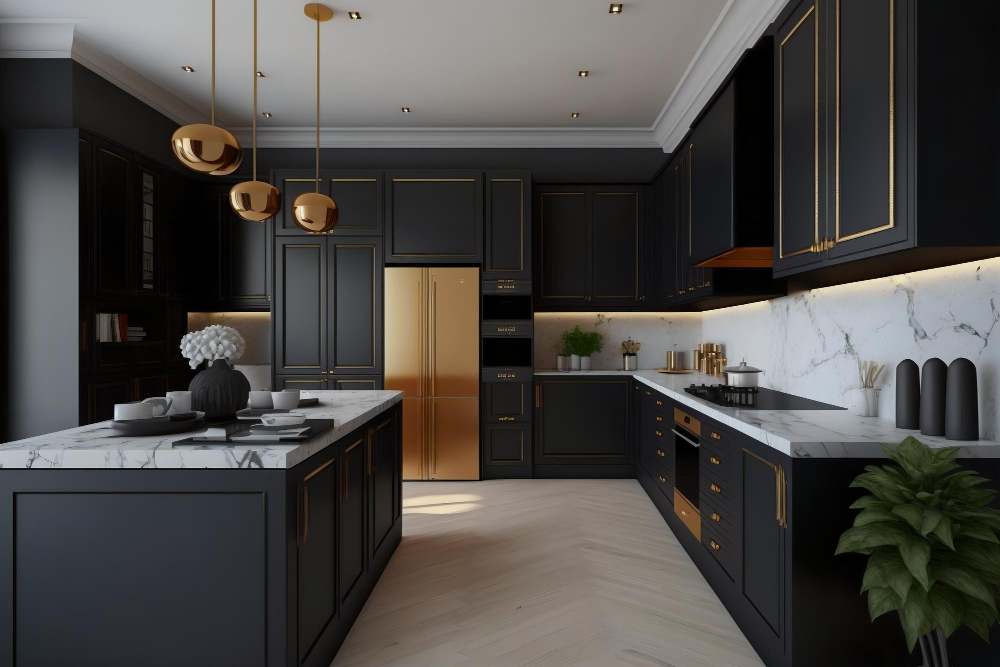
Gold accents can add warmth, depth, and glamour to any space. The key is not to overdo it; too much gold can be overwhelming and take away from the beauty of your grey units.
One way you could incorporate this color scheme into your kitchen design would be by adding golden hardware such as cabinet handles or drawer pulls. This simple addition will instantly elevate the overall aesthetic appeal of your space without breaking the bank.
Another option would be incorporating metallic gold accessories like vases, candle holders or even small appliances like kettles or coffee makers on open shelves in order for them stand out against the cool tones of gray cabinetry.
If you’re feeling bold enough, consider adding a statement piece such as a chandelier with golden accents above an island benchtop that will draw attention while also creating visual interest in what might otherwise have been just another plain white ceiling!.
Coordinating Kitchen Appliances
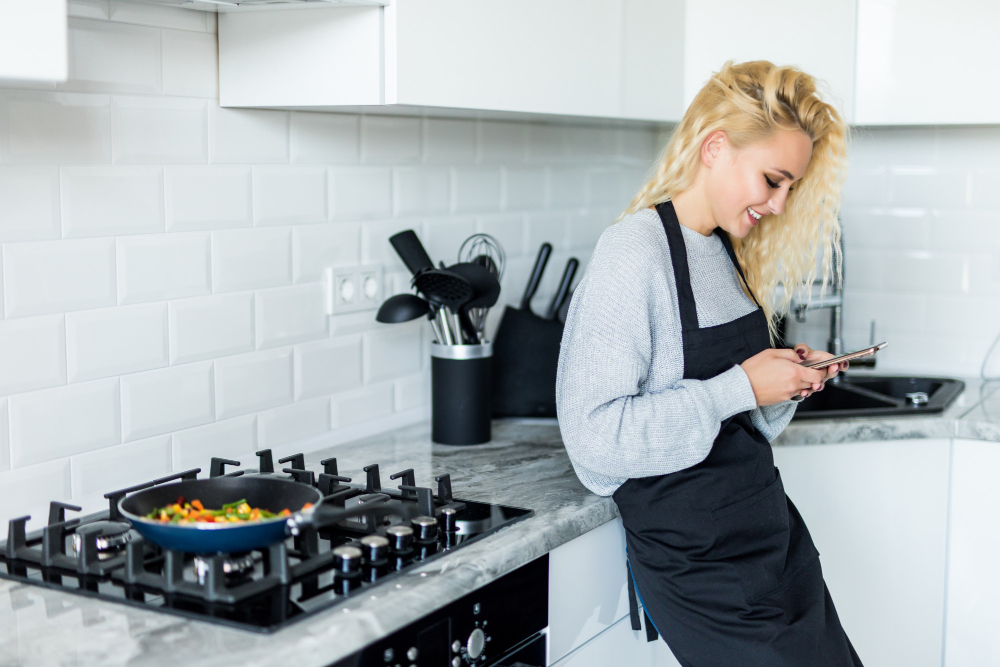
Coordinating your appliances with your grey kitchen units is essential for creating a cohesive and stylish look. Stainless steel is always a popular choice as it complements almost any color scheme and adds an element of sophistication to the space.
However, if you’re looking for something different, consider matching black or white appliances with your grey cabinets. Black stainless steel has become increasingly popular in recent years due to its sleek appearance and ability to hide fingerprints.
Another option is choosing colorful retro-style appliances that add personality and charm to the room while still coordinating with the rest of your design elements.
Ultimately, when selecting kitchen appliances for a grey-themed space, keep in mind that they should complement rather than compete with each other.
Balancing Colors in Open Layouts
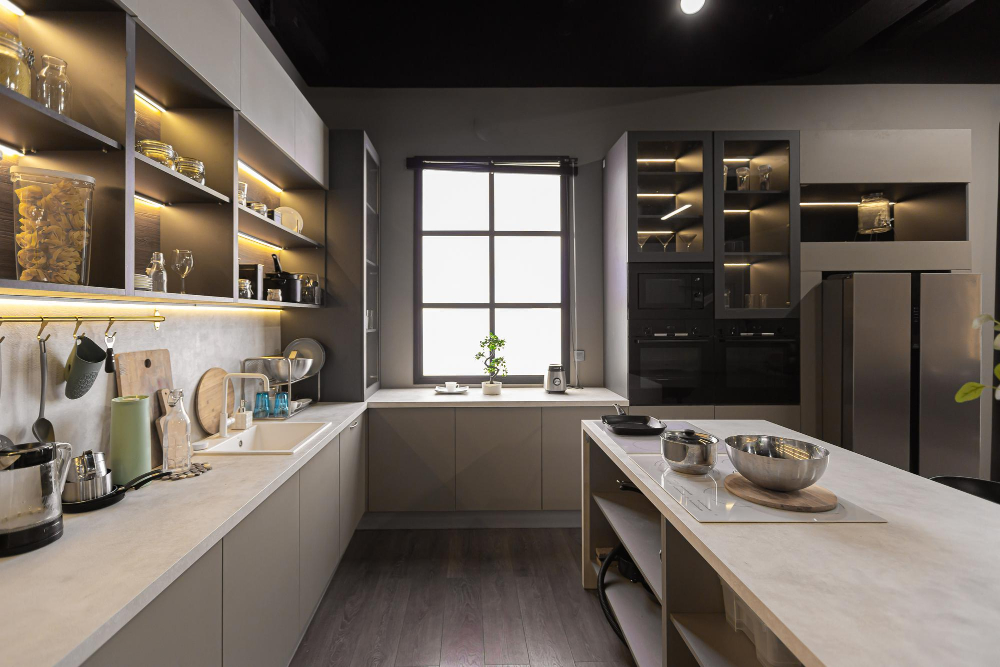
However, it can be challenging to balance colors in open layouts without overwhelming the senses or creating an unappealing contrast. When designing your grey kitchen with an open layout, consider using complementary colors that blend seamlessly into each other.
For instance, if you have grey kitchen units and want to add some warmth to your space while maintaining a neutral palette, consider pairing them with warm beige or cream-colored walls. You could also incorporate natural wood textures for added warmth and texture.
Another way of balancing colors is by using accent pieces such as throw pillows or curtains that match the wall color but have different patterns or textures than those on your furniture pieces. This creates visual interest without overpowering any one element of the room.
Accessorizing With Colors and Patterns
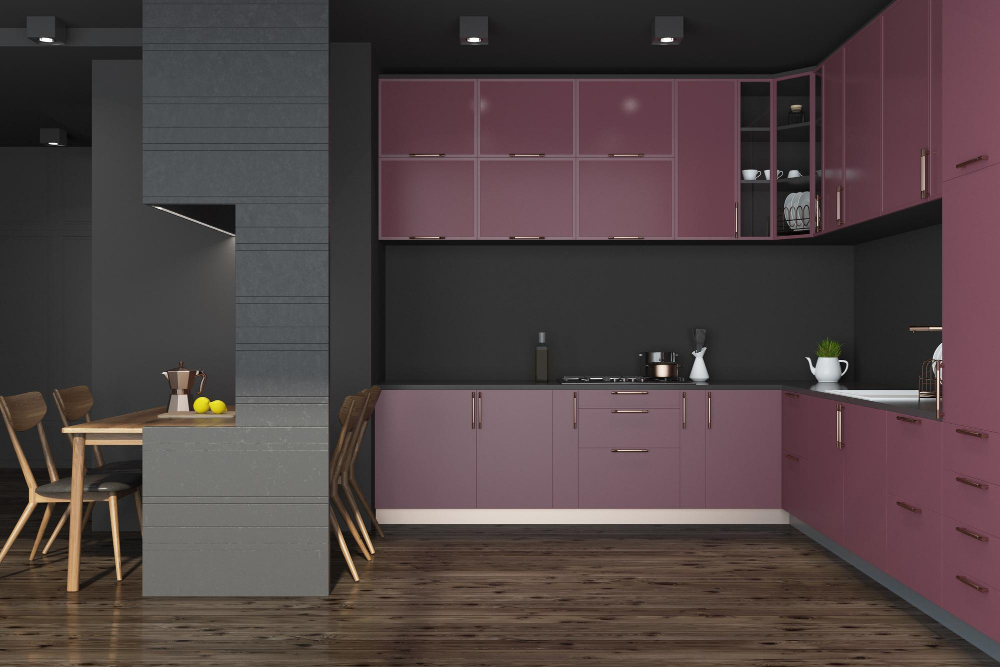
One way to do this is by accessorizing with colors and patterns that complement your chosen palette. For instance, if you’ve opted for a neutral color scheme of greys and whites, consider adding pops of bold colors like red or yellow through accessories such as cushions or curtains.
Alternatively, if you prefer a more subtle approach, try incorporating patterned textiles into your kitchen design. A striped rug or floral tablecloth can add interest without overwhelming the space.
When accessorizing with colors and patterns in a grey kitchen, it’s important not to go overboard. Stick to one or two accent hues at most so that they don’t clash with each other or compete for attention against the main color scheme.
Accessorizing is an excellent way of adding personality while keeping things simple in any room decor; however when doing so in a gray-themed kitchen ensure not going overboard on colours but rather stick within one hue family at most!.
FAQ
What wall colour goes with grey kitchen cabinets?
Answer: Neutral colours, specifically crisp white or creamy shades, complement grey kitchen cabinets, allowing minor details like copper and gold hardware to stand out.
What colours compliment grey?
Colors that compliment grey include cool tones like blue, pale greens, and cool white for lighter greys, and warm tones like burnt orange, mustard, and teal for darker greys.
What goes with gray kitchen?
Answer: Gray kitchen pairs well with gold, leather, black, brushed nickel, chrome, and white, and can be styled with various contrasts using dark and light hardware and cabinets.
What colors go with light grey kitchen?
Light grey kitchens pair best with white, pastel shades like pink and green, while dark grey kitchens go well with brighter hues like gold, pink, or deep blue.
Which countertop colors pair well with grey kitchen units?
Countertop colors such as white, black, and beige pair well with grey kitchen units.
How can I use accent colors to enhance my grey kitchen design?
Incorporate accent colors in accessories or small appliances like a colorful backsplash, curtains, or kitchenware to enhance your grey kitchen design.
What backsplash colors complement grey kitchen cabinets?
Backdrop colors that complement grey kitchen cabinets include white, beige, blue, and soft greens.




